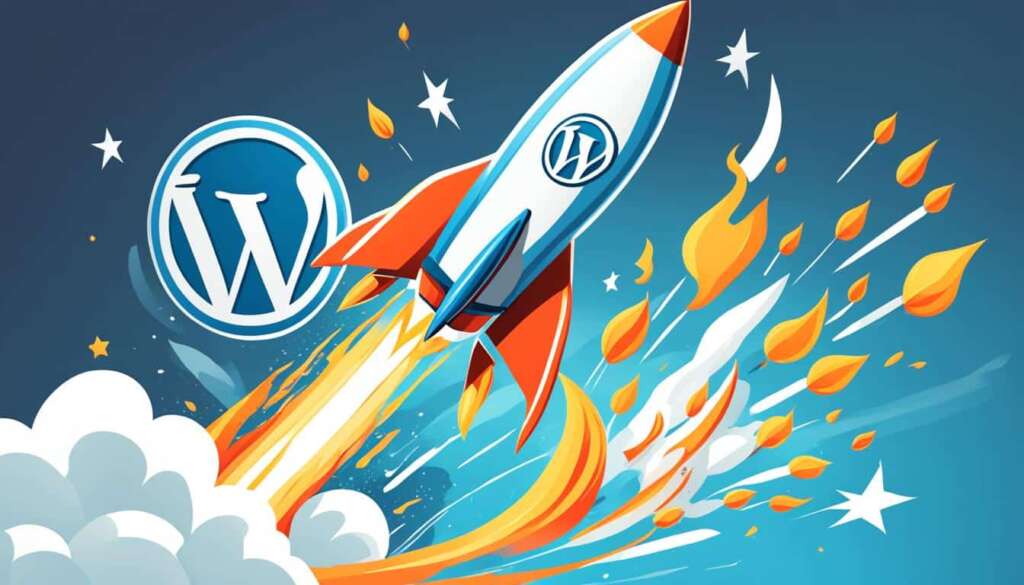Table of Contents
In this article, we will explore proven strategies on how to speed up a WordPress website and enhance its performance to maximise user engagement. By following these efficient techniques, you can optimise your website’s loading time and create a seamless user experience.
Key Takeaways
- Speeding up your WordPress website enhances performance and improves user engagement.
- Evaluate your current website speed to identify performance issues.
- Choose a reliable hosting provider with a fast server response time.
- Optimize images by reducing file sizes without compromising quality.
- Utilize caching techniques to store static versions of your website and improve response time.
Evaluate Current Website Speed
Before taking any steps to improve your website’s speed, it is essential to evaluate its current performance. By evaluating the website speed, you can identify areas that need improvement and diagnose any underlying performance issues that may be affecting the loading time.
To evaluate your website speed, you can use tools like GTmetrix or Pingdom. These tools measure the loading time of your website and provide valuable insights into its performance. They offer detailed reports, including information on page size, load time, and the number of HTTP requests made by your website.
Once you have evaluated your website speed, you can identify potential performance bottlenecks that may be causing slow loading times. These bottlenecks could include large file sizes, excessive server requests, or inefficient coding practices. By diagnosing these issues, you can work towards optimizing your website for faster loading speeds.
Remember, a slow website can negatively impact user experience, leading to higher bounce rates and lower conversions. By evaluating your website speed, you can take proactive measures to enhance the user experience and improve your website’s overall performance.
Choose a Reliable Hosting Provider
Selecting a reliable hosting provider is crucial for optimizing your website speed. When it comes to website performance, every second matters. A hosting provider plays a significant role in determining how quickly your website loads and performs for your visitors.
Server response time: One of the key factors to consider when choosing a hosting provider is their server response time. This refers to the time it takes for the server to process a request and deliver the initial HTML content to a visitor’s browser. A hosting provider with a fast server response time ensures that your website loads quickly, improving the overall user experience.
Uptime guarantee: Ensure that the hosting provider offers a reliable uptime guarantee. Uptime refers to the amount of time your website is accessible and available to visitors. A reputable hosting provider will have a high uptime guarantee, minimizing downtime and ensuring your website is always up and running smoothly.
Scalability: Consider the scalability options provided by the hosting provider. As your website grows and attracts more visitors, you may need to scale up your resources to accommodate the increased traffic. Choose a hosting plan that allows for easy scalability and can handle your website’s future growth.
Review different hosting plans offered by reliable providers such as Bluehost, SiteGround, and WP Engine. Assess their features, pricing, customer reviews, and reputation in the industry. Look for hosting plans that align with your website’s requirements and growth goals. By choosing a quality hosting provider, you can significantly improve your website’s loading speed and provide a seamless experience for your visitors.

Comparison of Leading Hosting Providers
| Hosting Provider | Server Response Time | Uptime Guarantee | Scalability |
|---|---|---|---|
| Bluehost | |||
| SiteGround | |||
| WP Engine |
Optimize Images
Images play a significant role in website loading times. Optimizing your images can have a substantial impact on reducing loading speed and improving user experience. By reducing the file size of your images without compromising quality, you can enhance website performance.
To optimize your images, consider using image compression plugins or online tools. These tools allow you to compress your images before uploading them to your WordPress site, reducing their file size while maintaining visual appeal. Compressed images load faster, resulting in quicker page load times.
Reducing the file size of your images not only helps with loading speed, but it also saves server bandwidth and improves overall website performance. By implementing these optimizations, you can create a seamless user experience that encourages longer visits and higher engagement.
Remember to use descriptive alt attributes when inserting images on your website. Alt attributes improve accessibility and provide relevant information to search engines, helping with SEO.
To further enhance your website’s loading speed, consider lazy loading techniques, where images only load when they become visible on the user’s screen. This technique reduces the initial payload, resulting in faster initial page load.
Benefits of image optimization:
- Improved website loading speed
- Enhanced user experience
- Reduced server bandwidth
- Better overall website performance
Utilize Caching
Caching is a powerful technique that can significantly speed up your WordPress site. By implementing page caching and browser caching, you can optimize the loading time and improve the overall performance of your website.
Page caching involves storing static versions of your website pages, reducing the server’s load and enhancing response time. When a user visits your site, the cached version is displayed, eliminating the need for dynamic content generation with every request. This leads to faster page rendering and improved user experience.
Browser caching allows certain site elements, such as CSS files, JavaScript scripts, and images, to be stored on the user’s device. When the user revisits your website, these elements are loaded from the browser cache instead of being fetched from the server. This results in faster subsequent visits and reduced bandwidth usage.
To easily enable caching on your WordPress website, consider using caching plugins. These plugins offer user-friendly interfaces and configuration options, making it straightforward to implement and manage caching settings. Explore popular caching plugins like WP Rocket, W3 Total Cache, or WP Super Cache to take advantage of their caching features.
By effectively utilizing caching techniques, you can significantly improve your WordPress site’s performance, enhance user experience, and increase engagement.
Benefits of Caching:
- Reduced server load and improved response time
- Faster page rendering and improved user experience
- Lower bandwidth usage through browser caching
- Enhanced website performance and increased engagement
Minify CSS and JavaScript
In order to optimize the loading speed of your WordPress website, it is essential to minify CSS and JavaScript files. Minification is the process of reducing the file sizes of these files by removing unnecessary spaces, comments, and line breaks. By doing so, you can significantly reduce the amount of data that needs to be transferred, resulting in faster loading times.
Minifying CSS and JavaScript files can be easily accomplished by using dedicated plugins or online tools. These tools automatically remove the excess code while ensuring that the functionality of your website remains intact. By reducing the file size of these files, you can drastically improve the performance of your WordPress site and enhance user experience.
To further illustrate the benefits of minifying CSS and JavaScript, consider the following example:
Before Minification:
function calculateSum(a, b) { // This function calculates the sum of two numbers return a + b; }After Minification:
function calculateSum(a,b){return a+b;}
In the above example, the unnecessary spaces, comments, and line breaks have been removed through minification. As a result, the file size has been significantly reduced, leading to quicker load times.
Incorporating minification into your WordPress website’s development process is a recommended practice that can greatly impact its performance. By reducing the file size of CSS and JavaScript files, you not only improve loading speed but also contribute to a more efficient website.
Implementing minification techniques can help optimize your WordPress website and ensure a fast and seamless user experience. Consider utilizing available minification plugins or online tools to effortlessly reduce file sizes without compromising website functionality.
Optimize Database
WordPress stores all website data in its database. Regularly optimize and clean up your database to remove unnecessary data and optimize queries. By keeping your database lean and efficient, you can improve website performance and speed.
When it comes to database optimization, there are a few techniques you can employ to optimize the performance of your WordPress site:
1. Database Cleaning
Performing regular database cleanups is crucial for maintaining optimal performance. Remove any unnecessary data such as post revisions, spam comments, unused plugins, and themes. Deleting these unneeded items will reduce the size of your database, resulting in faster database queries.
2. Optimize Database Queries
Database queries are commands that retrieve and manipulate data in your WordPress database. Poorly optimized queries can slow down your site’s performance. Optimize your database queries by using efficient indexes, avoiding unnecessary joins, and optimizing complex queries for improved performance.
3. Utilize a Database Optimization Plugin
There are several plugins available that can help you optimize your WordPress database effortlessly. These plugins provide features such as automatic scheduled cleanups, database optimization, and repairs. Consider using popular plugins like WP-Optimize or WP Rocket to streamline your database maintenance tasks.
4. Optimize WordPress Database Tables
You can optimize your WordPress database tables to free up space and improve performance. This process involves reorganizing the physical storage of data, thereby reducing the time required to retrieve information. Utilize the “Optimize Tables” function within your database optimization plugin or run SQL commands to optimize individual tables.
Database Optimization Benefits
Optimizing your WordPress database offers several advantages:
- Improved Website Performance: A lean and efficient database leads to faster loading times and improved overall site performance.
- Enhanced User Experience: A faster website improves user satisfaction, reduces bounce rates, and increases engagement.
- Better SEO Rankings: Search engines consider website speed as a ranking factor. Optimizing your database can contribute to better search engine rankings and visibility.
- Reduced Server Load: By optimizing your database, you reduce the server load, which can result in cost savings and improved website scalability.
By regularly optimizing and cleaning up your WordPress database, you can ensure your site is running at peak performance and providing a seamless experience for your visitors.
| Optimizing Your WordPress Database | Unoptimized Database | Optimized Database |
|---|---|---|
| Size | Large size due to unnecessary data | Reduced size through data cleanup |
| Performance | Slow loading times and sluggish performance | Improved loading times and better performance |
| User Experience | Higher bounce rates and decreased user engagement | Enhanced user experience and increased engagement |
| SEO Ranking | Poor search engine rankings | Potential improvement in search engine rankings |
Conclusion
In conclusion, implementing these strategies can greatly enhance the performance and user engagement of your WordPress website. By following these steps, you can create a faster, more efficient, and user-friendly website.
First, it is crucial to evaluate your website’s current speed and diagnose any performance issues that may be affecting its loading time. Tools like GTmetrix or Pingdom can help you measure the loading time and identify areas that need improvement.
Next, choose a reliable hosting provider that can ensure fast server response time and uptime guarantee. A quality hosting provider plays a vital role in optimizing your website’s speed.
Optimizing images is another key aspect. By reducing the file size of your images without compromising their quality, you can significantly improve the loading speed. Consider using image compression plugins or online tools for this purpose.
Utilizing caching is another powerful technique to speed up your WordPress site. Implement page caching to store static versions of your website and enable browser caching to store certain site elements on the user’s device. Caching plugins can make this process much easier.
Additionally, minify your CSS and JavaScript files by removing unnecessary spaces, comments, and line breaks. This reduces the file size and enhances the loading speed of your website. Minification plugins or online tools can assist you in this process.
Finally, optimize your website’s database by regularly cleaning up unnecessary data and optimizing queries. This helps in maintaining a lean and efficient database, leading to improved performance and speed.
By following these strategies, you can boost your WordPress website’s speed efficiently and create a seamless user experience, ultimately enhancing user engagement.
FAQ
How can I assess the current speed of my WordPress website?
To evaluate the current speed of your WordPress website, you can use tools like GTmetrix or Pingdom. These tools measure the loading time and provide insights into any performance issues that may be affecting the speed.
Why is choosing a reliable hosting provider important for website speed?
Selecting a reliable hosting provider is crucial for optimizing the speed of your WordPress website. Factors such as server response time, uptime guarantee, and scalability play a significant role in website performance. Choosing a quality hosting provider can greatly improve your website’s loading speed.
How can I optimize the images on my WordPress site?
To optimize images on your WordPress site, you can reduce their file size without compromising quality. You can use image compression plugins or online tools to compress images before uploading them. By reducing the file sizes of your images, you can greatly improve the loading speed of your website.
What is caching and how can it speed up my WordPress site?
Caching is a technique that can significantly speed up your WordPress site. Implementing page caching allows static versions of your website to be stored, reducing the server’s load and improving response time. Browser caching stores certain site elements on the user’s device, enabling faster subsequent visits. You can utilize caching plugins to easily enable caching on your website.
Why should I minify CSS and JavaScript files?
Minifying CSS and JavaScript files helps reduce their file sizes by removing unnecessary spaces, comments, and line breaks. By minimizing the amount of data that needs to be transferred, you can improve your website’s loading speed. There are minification plugins and online tools available to automatically minify these files without affecting their functionality.
How can I optimize my WordPress database?
Regularly optimizing and cleaning up your WordPress database is essential for improving website performance and speed. You can use plugins or run SQL commands to remove unnecessary data and optimize queries. Keeping your database lean and efficient can significantly enhance your website’s overall performance.
Why is it important to optimize my WordPress website for speed?
Optimizing your WordPress website for speed is crucial for enhancing its performance and user engagement. A faster website not only improves user experience but also positively impacts search engine rankings. By implementing strategies like evaluating website speed, choosing a reliable hosting provider, optimizing images, utilizing caching, minifying CSS and JavaScript, and optimizing the database, you can create a faster, more efficient, and user-friendly WordPress website.












